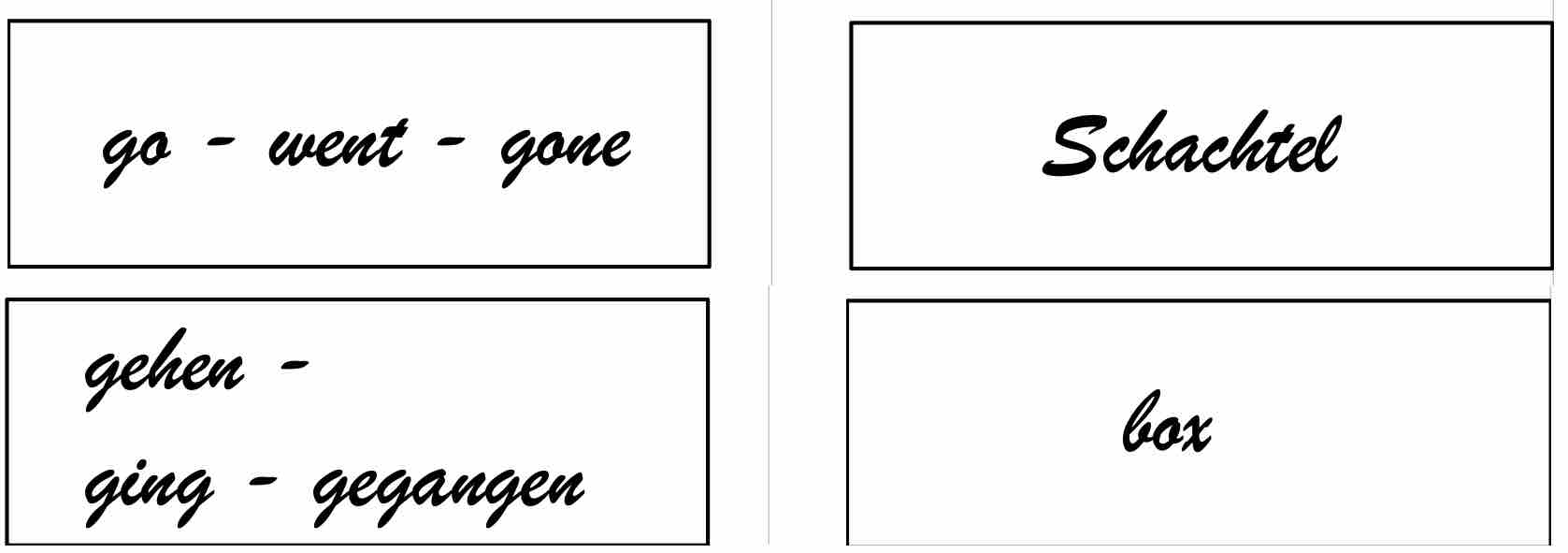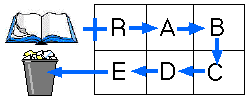When learning, practicing and repeating, a lot of time is wasted by working through parts of the material that you actually already know. This waste of time is especially common when learning vocabulary or similar small units of material. In order to spend only as much learning time as necessary, you need a learning machine that remembers what you have already learned and what is left to learn.
You can easily make such a learning machine yourself by providing a box with six subdivisions and cutting out many pieces of paper of the same size – at the beginning, two hundred pieces of paper will suffice. The slips of paper should be large enough so that you can write the German word – or a whole group of words – on one side and the translation of it on the back (we have had good experience with 7 x 3 cm cards). The empty slips of paper are now all put into the box R (reserve).
In the following picture you can see an example of such a learning machine.
To work with the learning machine, it must be filled with suitable fuel. We choose German vocabulary as an example here, but it also works with Latin, French and other learning materials, such as important history dates, formulas or terms from physics. Of course, each school subject needs its own learning machine!
To fill it with German fuel, it’s best to take your vocabulary notebook and work through it from the back to the beginning. Every vocabulary word that you don’t know right away goes on a piece of paper: on one side in German, on the other in English. You should always say the vocabulary words out loud. Here are two examples:
All the written words are placed in box A (beginning) the first time.
To get the learning machine going, every day you take about twenty pieces of paper from box A (at random!), read the first vocabulary word, think about the answer. Then you turn the paper over and check your answer.
If it was correct, say the word and the translation aloud and throw the paper into box B. If it was wrong, say the word and the translation aloud.
If it was wrong, then you say both sides of the piece of paper three times out loud and throw the piece of paper in box A.
Do this with all twenty slips of paper. It is important that you work with the learning machine every day.
If, after a few days, you have twenty or so vocabulary words in box B, then at the beginning of the learning process, you first take these words and work through them in the same way.
If the answer is correct, you say it out loud and throw the piece of paper into box C. If the answer is wrong, you say it out loud.
If the answer is wrong, then you say it correctly three times out loud and throw the piece of paper back into box A.
After that, about twenty slips of paper are taken from box A again.
If after a week or so you have about twenty words in box C again, then you start learning in this box first, before you work through twenty words from box B. Then you go back to the usual way of working through twenty words. Then it’s your turn to work through twenty or so words from box A, as usual.
Guess what: you do the same with box D when you have twenty vocabulary words in it – this will probably only be the case in two or three weeks. And for box E? Well, if the slips landed there, then if the answer is correct, the slips go into the trash. Because the vocabulary that has survived this learning machine is firmly fixed in your memory.
The following drawing summarizes the path that the notes take:
The secret of the learning machine is related to the way our memory works. Since each box (except for the first one) is only processed when it contains about twenty pieces of paper, you repeat the material in longer and longer time intervals. This way, the material is only ever refreshed in your mind when you don’t remember it very well. Box A is of course constantly filled with new vocabulary so that the machine never runs out of fuel.
An extra tip: You can also give the notes from box A a special treatment by holding a part of it together with a rubber ring and taking it with you in your trouser pocket to work through it on occasion (on the bus, while walking, during a break, while waiting for your girlfriend or boyfriend …). By the way, if you are in a good mood, you can work through even thirty notes of a box, but this is really the upper limit!
This learning machine is often found in some books as an elaborate flashcard with exact rules for how big the subjects have to be, when exactly you have to learn, how many vocabulary words have to be in each subject, and so on. Our simple learning machine gives you more freedom and works just as well.

